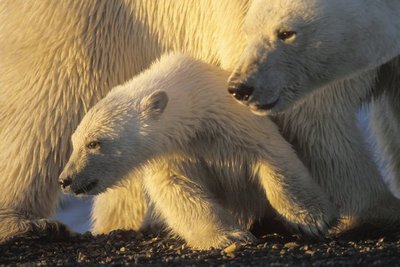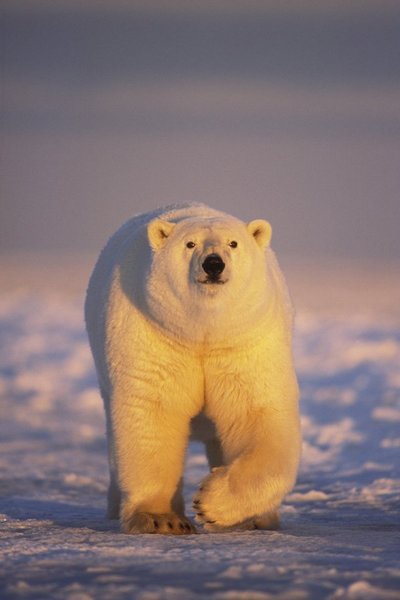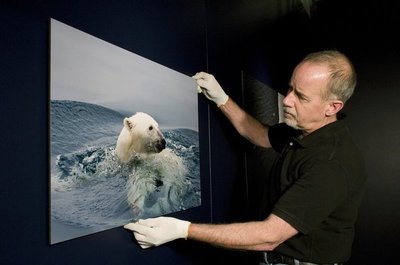June 26, 2008
Capturing a fading world: ‘The Last Polar Bear’ at the Burke Museum
It’s just not enough to say that wildlife photographer Steven Kazlowski’s work capturing polar bears on film was a labor of love. It was grander than that — it took eight years of patience, determination, creativity and extremely hard work.
The results are stunning. And, the photographer hopes, mind expanding.
“It’s pretty amazing to be around an animal so enormous and powerful that’s able to travel in this environment that’s like the moon to us,” Kazlowski said in a phone interview from his Seattle home. He added, “This environment is going to be lost. It’s disappearing right now, and it’s going to be gone.”
Forty of Kazlowski’s high-resolution images of polar bears and other animals in the Alaskan Arctic taken over those years will go on display Saturday at the UW’s Burke Museum of Natural History and Culture in the exhibit The Last Polar Bear: Facing the Truth of a Warmer World. The exhibit will run through Dec. 31.
A photography exhibit could hardly be more timely or newsworthy, with climate change constantly in the news and the listing May 14 of the polar bear as a “threatened” species under the Endangered Species Act.
Kazlowski grew up in New York state and earned a degree in biology from Towson University in Baltimore. He said though polar bears were not his goal when he started, he long wanted to become a wildlife photographer, particularly in the arctic regions of Alaska, and worked jobs on fishing boats and in construction toward that goal.
A chance meeting in Alaska with well-known wildlife photographer Subhankar Banerjee (whose own exhibit, Arctic National Wildlife Refuge: Seasons of Life and Land, came to the Burke in 2005) in the Arctic National Wildlife Refuge led Kazlowski to an introduction to Helen Cherullo, publisher at Mountaineer Books. “She’s been a driving force in this environmental type of photography,” he said.
A companion book, also titled The Last Polar Bear, has been published by Braided River, the conservation imprint of Mountaineer Books, and is available at the Burke. In addition to Kazlowski’s photos, the book features essays by Alaska-based writers Charles Wohlforth, Richard Nelson and Nick Jans, as well as Newsweek correspondent Dan Glick, Frances Beinecke, president of the National Resources Defense Council, and Theodore Roosevelt IV, conservationist and great-grandson of the president.
The photographs that make up the book and the exhibit show the polar bears and other Arctic species in their threatened natural habitat — swimming, playing, caring for their young, dozing on late-summer ice floes and, in one eye-popping image, appearing to roar into the viewer’s face. One of the first images in the book — also included in the exhibit — is of a polar bear floating comfortably in the pool at the Anchorage Zoo. The image, one of the last Kazlowski took, is beautiful but the caption reminds the reader of the reality: “If we do nothing as a society, and the ice continues to melt, zoos could be the only place on Earth where polar bears can be found.”
One photo in particular, though not of polar bears, heart-wrenchingly illustrates the changes wrought by climate change. It shows dozens of walrus cows, calves and juveniles crowded onto an obviously shrinking ice floe. A glance tells the tragic tale.
Talking about his work getting the photos in The Last Polar Bear, Kazlowski said in the Alaskan Arctic, wildlife is clustered through otherwise empty country. “It’s just a fact that wildlife tends to hang together … and then there are areas where there’s nothing for a hundred or so miles.”
He also said the endangered animals seem highly social. “What strikes me is how smart they are, they seem to have deep friendships with each other — they seem to have relationships just like we have, socially.”
Kazlowski said though it’s hard to earn a good living as a wildlife photographer, he plans to continue. “My real goal is to continue to give some kind of photographic history of what is up there and what changes are occurring,” he said. “Within 20 years it will be a different place than what it is now.”
The incredible images of The Last Polar Bear make a stronger case than mere words, though Kazlowski had a few final words to offer by way of warning: “Mother Nature has the last word,” he said, adding, “and she bats last.”
Meet photographer Steven Kaslowski
Seattle-based wildlife photographer Steven Kazlowski will be on hand for the official opening of The Last Polar Bear: Facing the Truth of a Warming World, 10 a.m. to 5 p.m. Saturday, June 28, at the Burke Museum.
Visitors to the Burke on opening day will be able to touch real polar bear pelts and other Arctic specimens, simulate the life of an explorer with a game called “Journey to the North Pole” and engage in other family-friendly activities.
Kazlowski will tour the exhibit with visitors. Also, polar bear experts Steven Armstrup of the U.S. Geological Survey’s Alaska Science Center in Anchorage, and Cindy Shogan, executive director of the Alaska Wilderness League, will be on hand to discuss the science and politics of the polar bears’ situation.



